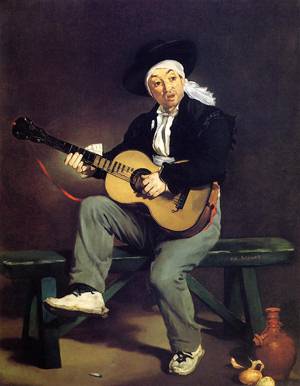Miami Symphony’s Spanish program introduces young composer and guitarist

"The Spanish Singer" by Edouard Manet,1860
The Miami Symphony Orchestra turned to the music of Spain for its current program, premiering a new work by an interesting young composer and introducing a gifted classical guitarist Saturday night at Gusman Concert Hall in Coral Gables. Familiar warhorses by Rodrigo and De Falla were also cheered by a supportive audience.
The concert opened with the first performance of Reconquista, System One World by Joaquin De Haro. The youthful Spanish-born composer has spent time at IRCAM in Paris studying avant garde music with Pierre Boulez and Marc Andre Dalbavie. Commissioned by the Miami Symphony, Reconquista is apparently meant as an environmental warning, which could not be more timely with the Japanese tsunami and attendant fears of nuclear radiation.
Conceived in two sections, the score often sounded like upscale film music. The initial rapid ostinato string and brass figurations could fit nicely into a chase sequence in a Bernard Hermann score for a thriller. A more interesting second part conjures up the sound world of a disaster flick. String players strike the wood of their instruments with both hands and bows. Dissonant brass and bass drum whacks, with exotic pitched percussion chimes, are heard over long string chords.
De Haro is clearly a skillful orchestrator. While his score hardly breaks new ground, the second half features some bracing and harmonically striking effects. Music director Eduardo Marturet is a dedicated advocate for new scores and led a high-voltage performance with the orchestra playing in peak form. The big climaxes had real visceral impact, and the portrait of immense disaster vividly etched in sound. De Haro was cheered by the audience.
Joaquin Rodrigo’s Concerto de Aranjuez is a surefire crowd pleaser and served as a grateful vehicle for Spanish guitarist Pablo Sainz Villegas. Winner of the Gold Medal at the Christopher Parkening International Guitar Competition in 2006, Villegas exudes technical aplomb and terrific command of the instrument. Still very much in competition mode, his performance seemed overemphatic at first but was ultimately persuasive. The unbridled vigor and super virtuoso sheen of Villegas’ playing in the outer movements and the languid lyricism of the famous Adagio exuded artistry as well as flashy pyrotechnics.
Marturet is a master at this type of score. He drew waves of orchestral color from his reduced forces, fashioning a sympathetic accompaniment and engrossing instrumental commentary. As an encore, Villegas offered the quirky Tango en Skai, by the Franco-Spanish crossover guitarist Roland Dyens, delivered with fiery abandon.
Music from De Falla’s Three Cornered Hat ballet found Marturet offering a generous eight-section suite rather than the usual short version. He brought insistent flamenco rhythms and considerable Andalusian coloring to a muscular but unsubtle performance. The harsh orchestral acoustics of the hall did not help matters in the sometimes ear-splitting climaxes.
Under concertmaster Daniel Andai, the Miami Symphony strings have become the orchestra’s most reliable asset, often carrying a performance. Fine clarinet, bassoon and oboe solos signaled marked improvement in the uneven wind section. Soprano Betsy Diaz voiced the opening flamenco canto in dusky tones.
The Miami Symphony Orchestra repeats the program 8 p.m. Sunday at the New World Center in Miami Beach. 305-275-5666;themiso.org.
Posted in Performances
Leave a Comment
Sun Mar 20, 2011
at 12:38 pm
No Comments






